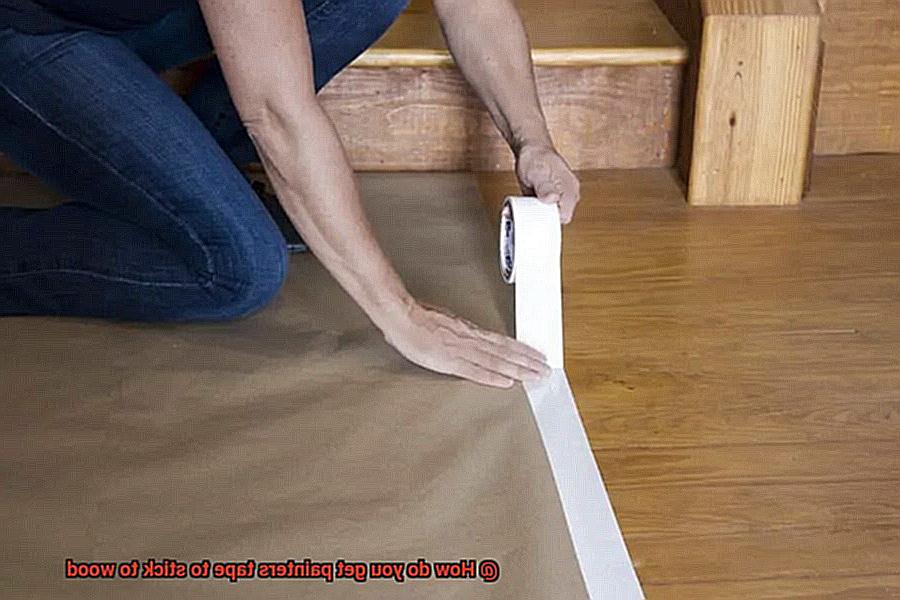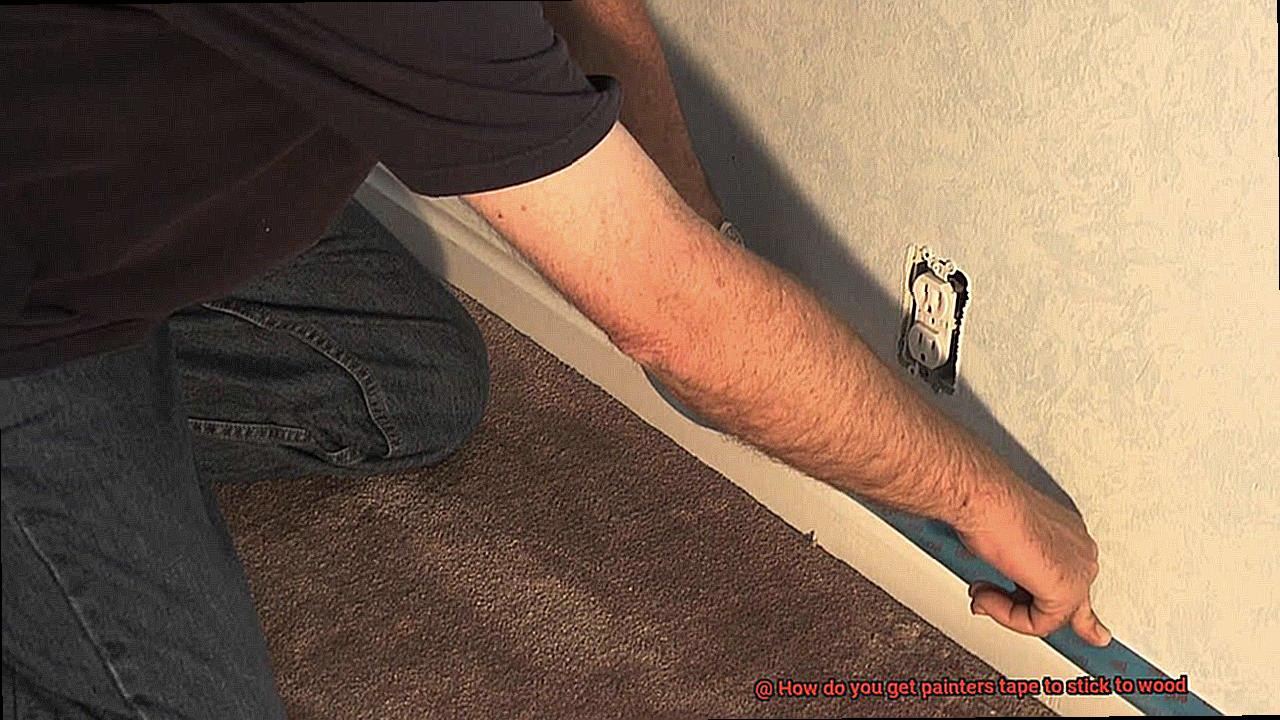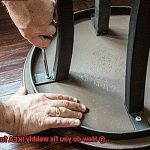When it comes to achieving a flawless paint job, painter’s tape is the unsung hero. Its ability to create clean lines and protect surfaces from errant brushstrokes is unmatched. But we’ve all had that frustrating moment when our painter’s tape just won’t stick to wood, leaving us questioning our DIY skills.
Well, fear not. In this ultimate guide, we’ll uncover the secrets to ensuring that your painter’s tape adheres perfectly to wood surfaces. Whether you’re a seasoned DIY enthusiast or a newbie taking on your first painting project, these tips and tricks will give you the knowledge you need to achieve professional results every time.
While technique plays a crucial role, optimal adhesion depends on factors like the type of wood, surface condition, and tape quality. Finding the right balance among these elements is key to success. So let’s explore tried-and-true methods that guarantee your painter’s tape sticks firmly to any wooden surface, allowing you to paint with confidence and precision.
Join us as we dive into the nitty-gritty of preparing wood surfaces, selecting the right painter’s tape, and using effective application techniques. By the end of this guide, you’ll have insider knowledge that will help you conquer any painting project on wood, leaving flawlessly painted surfaces with razor-sharp edges.
Get ready to up your painting game and unlock the secrets behind getting painter’s tape to stick triumphantly to wood.
Preparing the Wood Surface
Contents
When it comes to painting wood surfaces, achieving clean, sharp lines is essential for a professional finish. One crucial step in ensuring the tape adheres properly and prevents paint bleed-through is preparing the wood surface. In this blog post, we will guide you through the necessary steps to effectively prepare your wood surface for painters tape.
Step 1: Cleanliness is Key
Before applying painters tape, make sure your wood surface is clean and free from dust, dirt, or debris. Use a soft cloth or sponge with mild detergent to gently clean the surface. Pay special attention to removing any grease or oil stains that can hinder tape adhesion.
Step 2: Smooth it Out with Sanding
If the wood surface is rough or uneven, sanding is recommended. Start with coarse-grit sandpaper and gradually move to finer grits to achieve a smooth surface. This step ensures that the tape adheres evenly and prevents any lifting or peeling.
Step 3: Allow for Drying Time
After cleaning or sanding, allow the wood surface to dry completely. Any moisture can compromise the adhesive properties of the tape. Ensure thorough drying by either allowing enough time for air drying or using a clean, dry cloth to wipe away excess moisture.
Step 4: The Power of Primer
Consider using a primer on your wood surface before applying painters tape. A primer creates a barrier between the wood and tape, improving adhesion and preventing bleed-through of paint. Choose a primer suitable for your specific wood type and follow manufacturer instructions for application.
Step 5: Ideal Environment for Tape Adhesion
Temperature and humidity levels can affect how well painters tape sticks to wood. Aim for a moderate temperature (around 70°F) and low humidity environment when applying tape. High humidity can reduce adhesive effectiveness, while low temperatures can make the adhesive brittle.
Choosing the Right Tape
When it comes to sticking tape to wood surfaces, not all tapes are created equal. To ensure a clean and professional finish, it’s important to choose the right tape for the job. Here are some key elements to consider when selecting tape for wood surfaces:
- Adhesive Strength: The adhesive strength of the tape is crucial in determining its effectiveness on wood. Look for tapes labeled as “high adhesion” or “for wood surfaces.” These tapes are specially formulated with stronger adhesive properties that can stick firmly to wood without causing damage.
- Surface Texture: Consider the texture of the wood surface. If it’s rough or uneven, opt for a tape with a thicker backing. This will help the tape conform to the irregularities of the wood and provide better adhesion.
- Duration of Adhesion: Think about how long you’ll need the tape to stick to the wood. If you’re planning on multiple coats of paint or using stain or varnish, choose a tape designed for extended adhesion. These tapes have stronger adhesive properties that can withstand prolonged exposure to finishes.
- Temperature and Humidity Conditions: Take into account the temperature and humidity conditions in which the tape will be applied. Some tapes are designed to perform better in high humidity or extreme temperatures, ensuring that they maintain their stickiness even in challenging environments.
- Reviews and Recommendations: Don’t forget to read reviews and recommendations from other users who have used painters tape on wood surfaces. Their experiences can provide valuable insights into which tapes work best in specific situations.
By considering these factors and choosing a tape with appropriate adhesive strength, thickness, durability, and compatibility with wood surfaces, you can ensure that your tape sticks securely and provides clean removal without any damage or residue left behind.
Priming the Wood Surface
Preparing the wood surface is a crucial step in ensuring that your painters tape sticks securely and creates clean, crisp paint lines. Let’s dive into the process of priming the wood surface, step by step.
First and foremost, you need to start with a clean canvas. Remove any dirt, dust, or debris from the wood surface by using a mild detergent and water solution or a specialized wood cleaner. Think of it as giving your wood surface a refreshing spa treatment, washing away any impurities.
Once the surface is squeaky clean, it’s time to give it a little rough love. Lightly sand the wood to create a rougher texture. This helps the primer adhere better to the surface. Grab some fine-grit sandpaper and work in the direction of the wood grain. Feel the wood beneath your fingertips transform into a velvety smoothness.
After sanding, it’s time to banish any lingering dust particles. Wipe away all traces of dust using a tack cloth or a clean, lint-free cloth. We want nothing to interfere with our tape sticking perfection.
Now comes the star of the show – primer. Choose a primer specifically designed for wood surfaces and one that is compatible with both the type of wood and paint you will be using. Apply the primer evenly over the entire wood surface using a brush or roller. Watch as it effortlessly glides over the wood, creating a protective barrier.
Don’t forget to follow the manufacturer’s instructions regarding drying time and number of coats required. Patience is key here. Allow the primer to dry completely before moving on to the next step. You can almost hear the anticipation building as you wait for your masterpiece to take shape.
Once the primer is dry, you are ready to confidently apply painters tape to your primed wood surface. The tape should stick like glue (pun intended) and stay in place throughout your painting journey. Feel a sense of satisfaction as you witness the tape adhering firmly, ensuring clean lines and a professional finish.
It’s important to note that priming is not always necessary if you’re using high-quality painters tape that’s designed for use on various surfaces, including bare wood. However, priming can provide an extra layer of adhesion and ensure better results. It’s like adding a secret ingredient to make your tape stick like a superhero.
Applying the Painters Tape
Before you dive into the colorful world of painting, let’s take a moment to appreciate the unsung hero of every successful project – painters tape. This magical adhesive tape is the secret weapon for creating clean, crisp lines and protecting surfaces that you don’t want to get paint on. But how do you apply it properly to a wooden surface? Fear not, my friend. I’ve got you covered with this comprehensive guide that will turn you into a painters tape pro.
Step 1: Cleanse the Surface
Prepare your wooden canvas by wiping away any dust or debris. Grab a clean cloth or brush and give it a thorough cleanse. Trust me, this step is crucial for ensuring that the tape sticks like glue.
Step 2: Choose the Perfect Tape
Just like choosing the perfect shampoo for your hair, selecting the right painters tape is essential. Opt for a tape specifically designed for delicate wooden surfaces. You want something gentle and nourishing for your wood.
Step 3: Tape it Up
With your tape in hand, tear off a piece slightly longer than the area you want to cover. Start by gently pressing one end onto the wood surface and slowly unroll it while applying light pressure. Keep in mind that straight and aligned lines are all the rage.
Step 4: Apply Gentle Pressure
Avoid stretching or pulling the tape too tightly – disaster alert. Instead, apply gentle pressure along the length of the tape to ensure it adheres well without losing its adhesive powers.
Step 5: Overlapping Magic
For projects that require multiple pieces of painters tape, embrace the art of overlapping. Slightly overlap the pieces to create seamless lines and press down firmly on the edges to secure their friendship forever.
Step 6: Finger Check
Once all the tape is applied, run your finger along the edges to make sure they’re firmly stuck down. This step is crucial for preventing any paint from sneaking underneath and ruining your masterpiece.
Step 7: Timing is Everything
Remember, painters tape is not meant to be a permanent fixture. Like a temporary tattoo, it’s fun for a while, but eventually, you need to let it go. Remove the tape within 24 hours of applying the paint to avoid any damage to the wood surface.
Step 8: Farewell, Tape
When it’s time to say goodbye to your trusty tape, do so with care. Pull it back at a 45-degree angle, away from the painted surface. This will prevent any unwanted peeling or paint chipping. If you encounter any resistance or stubborn tape, give it a little help with a utility knife or razor blade.
Enhancing Adhesion with Heat
Today, we’re diving into the fascinating world of adhesion and how heat can be a game-changer when it comes to applying painters tape to wood surfaces. So, grab your cup of coffee and let’s get right into it.
You may have heard that applying heat to painters tape can enhance its adhesion, but do you know why? It all comes down to the adhesive on the tape. When heat is applied, it softens the adhesive, allowing it to bond more effectively with the wood. This means no more pesky paint bleed or uneven lines.
Before applying heat, make sure to thoroughly clean the wood surface. Remove any dirt, dust, or oils that could interfere with adhesion. Trust me, this step is crucial for achieving that flawless finish.
Once your surface is clean and prepped, you can apply the tape. But here’s where the magic happens – heating it up. You have a couple of options when it comes to applying heat. You can use a hairdryer or a heat gun – whichever you prefer.
As you heat the tape, make sure to apply even heat across its entire length. This ensures consistent adhesion and prevents any weak spots. Take your time and be patient – good things come to those who wait.
After heating, don’t forget to apply pressure to the tape. This step further enhances adhesion and ensures that it sticks like glue (pun intended). A firm press with your fingers or a smooth tool should do the trick.
Now, a word of caution – excessive heat can damage the wood surface. So, be careful not to go overboard with the temperature. Start with lower settings and gradually increase if needed.
It’s important to note that the effectiveness of heat in enhancing adhesion may vary depending on the type of painters tape and the specific wood surface you’re working with. Some experimentation might be necessary to find the ideal temperature and duration for maximum adhesion.
So, there you have it – the secret to achieving perfect tape application on wood surfaces. Heat is your new best friend when it comes to enhancing adhesion and creating those clean lines we all strive for.
Applying Multiple Layers of Tape

Discover the power of applying multiple layers of tape to achieve impeccably clean lines on wood surfaces. In this guide, we will explore the step-by-step process and the numerous benefits it offers. Prepare to elevate your projects with precision and perfection.
Step 1: Preparation for Perfection
Before delving into tape application, prepare the wood surface meticulously. Wipe away dust and debris, leaving no trace. This ensures optimum adhesion for the tape, setting the stage for exceptional results.
Step 2: The Foundation Layer
Begin by applying the first layer of painters tape onto the wood surface. Utilize a tape dispenser or straight edge tool for sharp, straight lines. Firmly press down along the edges, ensuring a secure bond. This initial layer acts as the foundation for subsequent layers.
Step 3: Layer upon Layer
For added protection or intricate designs, add more layers of tape. Each new layer should overlap slightly with the previous one, creating a seamless line when painting. Embrace the potential for complexity and depth in your creations.
Step 4: The Power of Adhesion
To prevent paint seepage, firmly press down on each layer. Use your fingers or a small roller tool to apply consistent pressure along the edges. This crucial step guarantees clean and crisp lines throughout the painting process.
Step 5: Adjustments and Removal with Care
If adjustments are necessary or excess tape needs removal, exercise caution. Avoid tearing or lifting off the wood surface by gently lifting and repositioning the tape as needed. Maintain precision even during adjustments.
Step 6: Painting with Finesse
When painting over multiple layers of tape, embrace finesse. Apply thin coats of paint, allowing each coat to dry fully before proceeding. This technique prevents paint from seeping under the tape, preserving the sharpness of your lines. Emphasize quality over quantity.
Step 7: Unveiling the Masterpiece
As the paint dries, carefully remove the tape while it is still slightly wet. Pull it away at a 45-degree angle, away from the painted surface. Witness the reveal of clean and sharp lines that transform your project into a professional masterpiece.
Step 8: Touch-ups and Final Flourishes
Address any paint bleeding or rough edges with precision. Utilize a small brush or touch-up tool dipped in the same paint color to rectify imperfections. This final step ensures attention to detail, leaving no room for compromise.
Removing the Tape After Painting
Painters tape is an invaluable tool for creating clean and precise lines while protecting areas that should remain unpainted. However, the task of removing painters tape after painting can be daunting if not done correctly, potentially leading to peeling paint or unsightly residue. In this comprehensive guide, we will explore expert tips and tricks for effortlessly removing painters tape without causing damage to your freshly painted surface.
Timing is Key:
Timing plays a crucial role in successfully removing painters tape. It is best to remove the tape while the paint is still slightly wet or tacky. This ensures a clean removal without pulling up the paint.
The Removal Process:
To begin, gently pull at one corner of the tape at a 45-degree angle. Avoid pulling straight back, as this may cause the paint to lift and create an uneven edge. If you encounter resistance while pulling, pause and use a utility knife or sharp razor blade to carefully cut along the edge of the tape. This technique releases any areas where the paint may have bonded with the tape.
Heat it up:
For stubborn tape or adhesive residue, employ the power of heat. Grab your trusty hairdryer and apply heat to the tape before attempting to remove it. The heat softens the adhesive, facilitating easy peeling without leaving behind any residue.
Dealing with Residue:
Should you notice any residue left behind after removing the tape, fear not. There are effective methods to tackle this issue. Try using a mild adhesive remover or rubbing alcohol on a clean cloth or sponge. Gently rub the residue until it lifts off. Always test adhesive removers on a small, inconspicuous area before applying them to larger sections of painted surface.
Final Touches:
Once all the tape and residue have been successfully removed, it is essential to give your painted surface some tender loving care. Cleanse it with a mild soap and water solution to remove any leftover adhesive or cleaning agents, guaranteeing a flawlessly clean and smooth finish.
Conclusion
In conclusion, achieving that perfect adhesion of painter’s tape to wood surfaces requires meticulous preparation, selecting the ideal tape, employing effective application techniques, and sometimes even harnessing the power of heat. By following these steps, you can ensure that your painter’s tape adheres securely to wood, leaving behind clean lines for a truly professional finish.
First and foremost, proper preparation of the wood surface is absolutely crucial. Thoroughly cleanse the surface, sand it if necessary to achieve a flawlessly smooth texture, allow it ample time to dry completely, and consider using a primer for enhanced adhesion.
Equally vital is choosing the right tape for the job. Seek out tapes specifically designed with high adhesive strength for wood surfaces. Take into account factors such as surface texture, desired duration of adhesion, prevailing temperature and humidity conditions during application, and don’t hesitate to delve into reviews and recommendations from fellow users.
When applying the tape itself, take care to cleanse the surface beforehand and apply it with gentle yet firm pressure. For added protection or intricate designs, overlapping multiple layers can work wonders. And if you really want to take things up a notch in terms of adhesion power, applying some heat can do just that by softening the adhesive.
Removing the tape after painting should be done while the paint is still slightly wet or tacky. Pull at a 45-degree angle with deliberate yet controlled force and have a trusty utility knife or razor blade on hand in case any stubborn bits need some extra persuasion. And remember, when all else fails in removing persistent tape or residue left behind, introducing heat into the equation can be an absolute game-changer.
To sum it all up, mastering this art of getting painter’s tape to stick flawlessly to wood involves meticulous preparation techniques alongside selecting the perfect tape for your needs. Applying it correctly with just the right amount of pressure and utilizing overlapping techniques when necessary will guarantee those crisp lines you’re after. And when it’s time to bid farewell to the tape, removing it at the opportune moment and harnessing the power of heat if needed will ensure a flawless finish every single time.






